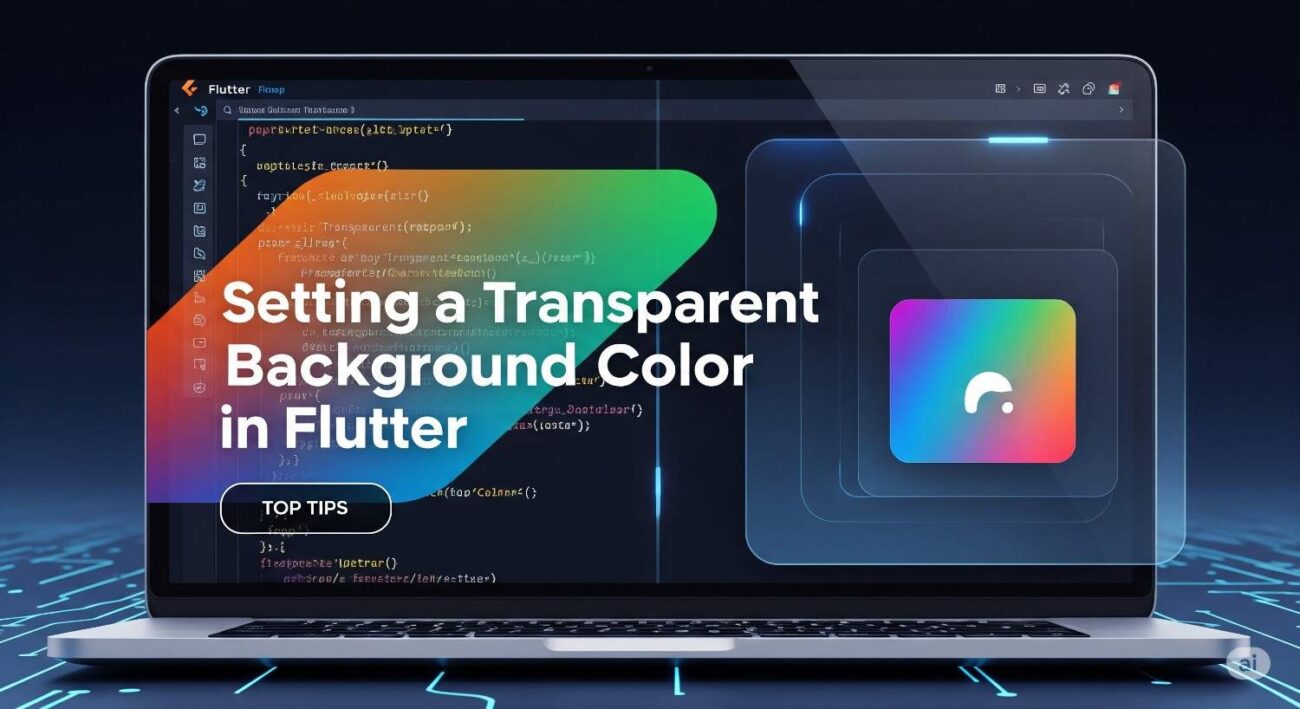Today, we’re tackling a common requirement that can add a touch of modern elegance to any app: setting a transparent background. Whether you’re trying to make an AppBar blend seamlessly with your content, overlay text on an image, or create stylish, layered designs, understanding transparency is key.
This guide will walk you through exactly how to do it, step-by-step.
The Basics: How to Create a Transparent Color
In Flutter, you can’t just set a background to “transparent.” Instead, you assign it a Color value that has a transparency level. There are two primary ways to get a transparent color.
1. The Easiest Way: Colors.transparent
For a fully transparent color, Flutter provides a handy, pre-defined constant: Colors.transparent. It’s clean, readable, and does exactly what it says.
You can use it with any widget that accepts a color property. For example, to create a Container with a completely invisible background:
Container(
color: Colors.transparent,
width: 100,
height: 100,
child: const Text('This container has a transparent background'),
)
2. For Partial Transparency: Color.fromARGB
What if you want a semi-transparent or translucent background, like a frosted glass effect? For this, you need to define a color with a specific alpha value. The alpha channel controls the opacity of the color, where 0 is fully transparent and 255 is fully opaque.
The Color.fromARGB() constructor is perfect for this. It takes four integer arguments: Alpha, Red, Green, and Blue.
// A semi-transparent black color
Color semiTransparentBlack = const Color.fromARGB(150, 0, 0, 0); // Alpha is 150 (out of 255)
// A semi-transparent white color
Color frostedWhite = const Color.fromARGB(200, 255, 255, 255); // Alpha is 200
Here’s how you’d use it to create a semi-transparent black overlay Container:
Container(
color: const Color.fromARGB(150, 0, 0, 0), // 58% opacity black
child: const Center(
child: Text(
'Frosted Glass Effect',
style: TextStyle(color: Colors.white, fontSize: 24),
),
),
)
Pro Tip: You can also use
withOpacity()on an existingColorobject. It’s often more readable:Colors.black.withOpacity(0.5). This takes a double from0.0(fully transparent) to1.0(fully opaque).
Practical Examples: Making Common Widgets Transparent
Now let’s apply these concepts to some of the most common widgets you’ll work with.
Transparent Scaffold Background
By default, the Scaffold widget has a background color defined by your app’s theme (usually white or black). To make it transparent, simply set its backgroundColor property. This is useful if you want to show a background image or a gradient that lives behind the Scaffold.
Stack(
children: [
// Your background (e.g., an image or gradient)
Container(
decoration: const BoxDecoration(
image: DecorationImage(
image: NetworkImage('https://picsum.photos/id/1015/1000/2000'),
fit: BoxFit.cover,
),
),
),
// Your Scaffold on top
Scaffold(
backgroundColor: Colors.transparent, // This is the key!
appBar: AppBar(
title: const Text('Transparent Scaffold'),
backgroundColor: Colors.black.withOpacity(0.3),
elevation: 0,
),
body: const Center(
child: Text(
'The Scaffold background is see-through!',
style: TextStyle(color: Colors.white, fontSize: 22, fontWeight: FontWeight.bold),
),
),
),
],
)
In the example above, we place a Container with a background image inside a Stack and then layer the transparent Scaffold on top of it.
Transparent AppBar
Creating a transparent AppBar is a popular design choice. You just need to set its backgroundColor to Colors.transparent. For a truly seamless look, you should also set the elevation to 0 to remove the drop shadow.
Scaffold(
// Use extendBodyBehindAppBar to allow the body to go behind the app bar
extendBodyBehindAppBar: true,
appBar: AppBar(
title: const Text('Transparent AppBar'),
backgroundColor: Colors.transparent,
elevation: 0, // Removes the shadow
),
body: Container(
// Your body content here, which will be visible behind the AppBar
color: Colors.blueGrey,
child: const Center(child: Text('Body Content')),
),
)
The extendBodyBehindAppBar: true property on the Scaffold is crucial here. It allows the body of the Scaffold to be built underneath the AppBar, creating the desired layering effect.
Layering Widgets with Transparency using Stack
The real power of transparent backgrounds comes to life when you use them with a Stack widget. The Stack widget allows you to place widgets on top of each other, making it perfect for creating complex, layered UIs.
Imagine you want to display some text information over an image inside a card.
Card(
clipBehavior: Clip.antiAlias, // Ensures the image respects the card's rounded corners
shape: RoundedRectangleBorder(borderRadius: BorderRadius.circular(16)),
child: Stack(
alignment: Alignment.bottomLeft, // Align content to the bottom-left
children: [
// 1. The background image
Image.network(
'https://picsum.photos/id/1062/400/300',
fit: BoxFit.cover,
width: double.infinity,
height: 200,
),
// 2. The semi-transparent overlay
Positioned.fill(
child: Container(
decoration: BoxDecoration(
gradient: LinearGradient(
colors: [Colors.black.withOpacity(0.6), Colors.transparent],
begin: Alignment.bottomCenter,
end: Alignment.topCenter,
),
),
),
),
// 3. The text content on top
const Padding(
padding: EdgeInsets.all(16.0),
child: Text(
'Exploring the Alps',
style: TextStyle(
color: Colors.white,
fontSize: 24,
fontWeight: FontWeight.bold,
),
),
),
],
),
)
In this example:
- We have an
Imageas the base layer. - We place a
Containerwith a transparentLinearGradienton top to ensure the text is readable against any image. - Finally, we add the
Textwidget.
This layering technique is fundamental to creating beautiful and professional-looking UIs in Flutter.
Final Thoughts
Mastering the use of transparent and semi-transparent backgrounds is a small step that can make a massive difference in your app’s visual appeal. By using Colors.transparent, Color.fromARGB(), and layering widgets with Stack, you have all the tools you need to create stunning, modern interfaces.
